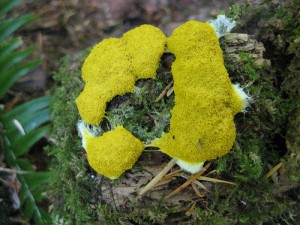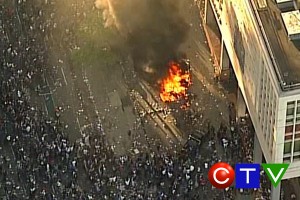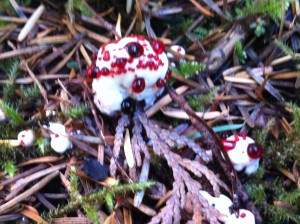violent matter
It’s been a great year for biomorphic assemblages. From riots to slime molds, I’ve seen them erupt into all kinds of new territory. Yet non-living materials can have a kind of agency too, as is argued eloquently by Jane Bennett in her book Vibrant Matter. Buildings and streets have strong influences on the people who use them, a design reality which we ignore at our peril.
Latour wrote of the ‘pasteurization’ of France and I’ve been inspired to take his idea further. The process of pasteurization reduces biological heterogenicity, killing bacteria with heat, with the aim of making the food we eat safer. Yet over-pasteurization and the ubiquity of antibiotics in the environment have reduced the ability of our bodies to deal with the background level of heterogenicity to the point where we are seeing an epidemic of autoimmune disorders, especially in the more affluent countries of the West. Denied the stimulation of heterogeneous agents, our systems will attack themselves. The current popularity of raw milk cheeses, probiotic yogurts and home-made sauerkraut is a response to this alimentary over-sterilization but what of the world beyond the stomach, in the man-made environments in which we all live?
The commercial architecture of many cities reflects an essentially ‘pasteurized’ aesthetic in which the visual field is dominated by sanitized, globalized, corporate brands that make it difficult to experience heterogeneous exchanges which are not somehow already commodified. These spaces convey the message that if you’re aren’t engaged in consuming (say) a Starbucks or a MacDonalds, you don’t belong – a highly pasteurized experience both literally and figuratively. Following the logic of the auto-immune disease, these placeless, sterilized zones with their deficit of heterogeneous authenticity will eventually attack themselves, which I would argue is one way of understand what happened during this summer’s Vancouver hockey riot.
The identity of the rioters is itself inconsequential. As a biological or ‘machinic’ assemblage, the riot could simply be construed as Vancouver attacking the linings of its own intestine, like Crohn’s disease or the way the normally commensal bacterium, Clostridium difficile becomes lethal after antibiotics wipe out competing organisms. The conditions leading up to the riot were essentially ecological and it is a waste of time to look for other culprits. Be it burning police cars or copious rectal bleeding, the remedy for such sudden attacks against the self is to foster heterogenicity. City cores needs texture and autonomous, self-organizing zones that exist outside the imprint of brutalist urban planning; places that are organic, interactive and humanizing.
Take for example Toronto’s Kensington Market. When I lived near there a quarter century ago, I would go out of my way to ply its narrow streets, among the crates of fish, occasionally putrefying fruits and animal carcasses swinging from hooks beneath the awnings. Yes it was dirty, crowded and chaotic. But it would have been impossible to conceive of a riot there. Kensington’s very heterogenicity – its ad hoc, polyglot assemblages of owner-run shops, with their wares and haggling customers spilling out onto the sidewalks and streets, would have dissipated any such monolithic energy before it even got started. Vancouver’s Stanley Cup riot presents us with a valuable object lesson in how not to design cities. Let’s hope that city planners and civic officials pay some attention. The current spate of condo development along the southern flank of False Creek is boring, classist and inorganic. The city deserves better.
On another tack, I was intrigued by the riot’s patterns of flow and counterflow, with crowds forming at the leading edge of points of rupture such as burning cars or smashed store fronts before being subsumed into an ever-reassembling periphery. These formations closely resemble the patterns formed by slime molds as individual amoebae that make up the collectivity (called a plasmodium), stream toward, or away from, stimulus. Like the slime mold, the riot is essentially a super-organism. The individual becomes subsumed.
That riots and slime molds share this basic biological pattern is perhaps not surprising and the resonance between these seemingly disparate phenomena further negates for me the initial knee-jerk response of the authorities, who tried to pin the riot on a few out-of-control individuals or an anarchist conspiracy. The events of last June were a biological inevitability. Under the right conditions, riots indeed are us.







Here’s that desertish looking fungus you found. They are not known to be poisonous, but taste horrible. They are also know to bioaccumulate some heavy metals.
http://en.wikipedia.org/wiki/Hydnellum_peckii
Salut Oliver!
Don’t you think it looks like a piece of marshmallow with strawberry jam on top? Mmmm! 🙂